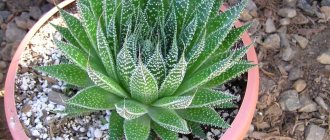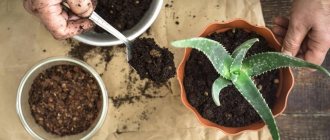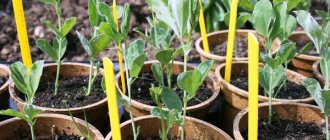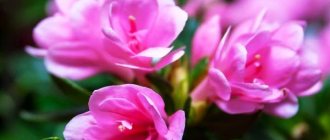Planting Aloe at home is a very common occurrence. This plant is grown primarily for its beneficial properties. Thus, Aloe Vera and Aloe Tree (Agave) have pronounced medicinal qualities. Aloe juice is used to treat inflammatory processes on the skin; it is also a good remedy for the common cold; extracts from the plant are used to produce cosmetics.
However, the appearance of a flower can serve as a decoration for a room. This is especially true for decorative varieties of aloe. For example, Aloe Variegated (otherwise known as Tiger). This flower looks very beautiful: small in size, the leaves are decorated with white stripes, spots, specks, and when flowering, beautiful bright orange inflorescences are formed.
Succulents
Aloe grows in large quantities in countries with arid climates (for example, Africa, Madagascar, the Arabian Peninsula). The plant is well adapted to long-term lack of moisture and belongs to the group of succulents. Succulents are a large part of the flora that are interconnected by their ability to adapt to unfavorable environmental conditions, namely long-term droughts. Such specimens have a special structure: thick, fleshy stems and leaves in which moisture accumulates, often characterized by spines, bristles or hairs (these are modified leaves).
22
Aloe perfectly withstands high and low temperatures, can survive without water for a long time, and does not require complex care. Even an untrained novice florist can easily grow this flower at home.
And yet, you need to know some of the features of Aloe breeding if you are truly passionate about plant growing and want to create the most comfortable conditions for your green pets.
The soil
If you don’t want to use ready-made soil for growing succulents, you can prepare the mixture yourself.
What kind of soil is needed for aloe ? Heavy fertile soil is not suitable for growing Aloe.
It is best to make soil for aloe from equal parts of leafy, clay-turf soil and coarse sand. This composition of soil for aloe will ensure good air and moisture permeability of the soil. A small addition of peat will acidify the soil; water will not stagnate in it after watering, which for succulents can lead to rotting of the stem and roots.
You definitely need to add one of the following to the soil to loosen it::
- brick chips;
- perlite;
- shell rock;
- expanded clay;
- fine gravel or crushed stone.
ATTENTION: a small layer of drainage at the bottom of the earth mixture must be required. It is better to mulch the surface of the soil in a flower pot with fine crushed stone or coarse sand.
How to properly plant aloe in a pot? The pot for growing Aloe should be small and flat . Its value should be related to the height of the plant in a ratio of 1:2. It is better to give the plant a little time in the spring to transfer it to a larger flower pot than to struggle with acidification of the soil in a container that is too spacious.
It is advisable that the flower pot be clay or terracotta . Such materials “breathe”, they have pores for air circulation, and the breathability of the earth mixture is very important for this plant. In addition, pots made from natural materials absorb excess moisture from the soil.
Check out other representatives of stem succulents:
- adenium;
- euphorbia;
- poinsettia;
- pedilanthus;
- Guernia;
- cotyledon;
- pachypodium;
- slipway.
Place
An ordinary window sill located in the south or east of the house is good for growing Aloe (the north side is a bad option). It should be well lit, but exposure to open sun is undesirable. Create a little partial shade - and the plant will thank you for your good care.
Use a plastic or terracotta pot as a container for planting a flower. These materials do not allow moisture to pass through well, which is good for the plant. The size of the planting container should be such that the root system feels spacious (there should be a gap of 3 cm between the walls and the root). We choose a pot with a shallow depth.
Advice! To determine whether there is enough space for a plant to stay comfortably, focus on the ratio of the length of the leaf to the diameter of the planting container: a ratio of 2:1 would be ideal.
Which pot should you choose?
When planning to move aloe into a new container, you need to know the requirements for the size of the pot. If the container is too large, the soil will leach out, the roots will rot, and the plant will stop developing. Pay attention to the material from which the pot is made.
Attention! A mandatory requirement for any pot is the presence of drainage holes in the bottom. A flowerpot with a solid bottom is not suitable for this purpose.
How to choose the right size?
There are several ways to determine the optimal pot size. It should be such that there is 1–2 cm of free space between the straightened roots and the walls and bottom of the vessel.
The required dimensions are also determined by the crown. A correctly selected container has a diameter that is 2 times smaller than the distance between the edges of opposing leaves. The older the plant, the more powerful its root. That's why they take more pot each time.
Another way to avoid making a mistake with your choice is to compare new and old containers. The diameter should increase by 3 cm.
Material selection
Pots are made of plastic and clay. Each material has its pros and cons. Plastic products have the following advantages:
- lungs;
- do not break when dropped;
- they are inexpensive.
The advantage of a clay pot is that the water in it does not stagnate for a long time due to the porous structure of the walls. Thanks to this, the roots do not heat up and do not rot even under the scorching rays of the sun. More weight gives stability, which the plastic counterpart does not have.
This is interesting. The aloe family includes over 300 species. The most popular among gardeners is tree-like. In its chemical composition, the plant is similar to the Madagascar true aloe, used for the production of cosmetics.
Priming
To plant Aloe, you can purchase ready-made soil for succulents. But if you want to prepare the soil yourself, you need to consider the following points:
- The soil should have good air permeability.
- It is advisable not to add peat to the composition.
- Recommended acid-base balance: neutral or low acidity.
In order to increase the airiness of the soil, the following loosening elements are used: river sand with large grains of sand, small broken brick, perlite, shells, expanded clay gravel.
The substrate usually includes the following components:
- A layer of clay mixed with a layer of turf.
- Sand or any other drainage layer.
- Leaf soil.
- Humus.
All elements are taken in equal shares. Drainage is placed at the bottom of the pot, then a layer of soil mixture, gravel pebbles or a layer of coarse sand are placed on top of the substrate.
When is the best time to propagate aloe?
Aloe succulents can be propagated all year round. But the most favorable time is considered to be spring and two summer months. At this time, aloe is undergoing a period of active vegetation and rapid rooting occurs. In other months, especially in winter, the rooting process will be slower and will only occur if a certain temperature regime is observed.
| On a note. The optimal temperature for rooting aloe sprouts in winter will be +16…+21 degrees. |
If we use seeds
With this method, sowing is done in the first months of spring. Prepare the soil in advance and select the required composition. The room temperature should be above 20 degrees. The container for sowing is small and narrow. The seeds are placed on the moist top layer of soil and covered with a thin layer of sand. The seeds should be buried 1 cm.
The seedlings are placed under film or glass and provided with the necessary care. At this time, sufficient watering is important; spraying of overgrown leaves is also used. After three large leaves appear, the seedlings are transplanted into separate small containers (no higher than 5 cm). After one year, the grown-up individuals are transferred to a permanent place in a large pot.
Using not the easiest possible seed propagation method, you can grow an entire plantation of succulents.
Useful care tips
Let's look at some useful tips that will help you grow a strong and healthy plant:
- In winter, the flower needs additional lighting, since the daylight hours are quite short. To do this, use fluorescent lamps, which are installed near the pot and turned on when it gets dark outside.
- Since aloe is a succulent, it loves changes in room temperature during the day and night, so it is recommended to ventilate the room well to slightly reduce the air temperature.
- The leaves can accumulate moisture, so nothing will happen to the flower if you forget about watering for a while, but you shouldn’t water it abundantly and regularly - it may start to rot.
- The plant loves good air circulation, so, if possible, ventilate the room more often.
- In the summer, the flower will feel better in the fresh air, so it is recommended to take the pot outside or to an open balcony.
Thus, planting and caring for aloe is accessible even to novice gardeners. If you follow the care recommendations and provide aloe with the necessary conditions, no problems usually arise during the growing process.
Propagation using cuttings, stem shoots, leaves
All these methods are similar to each other. To reproduce each of them, you will need to complete the following steps:
- Select a suitable fragment of the plant and cut it, the knife should be sharpened and washed well,
- The cut area needs to be well dried. The cut part is stored for about a week in the open air in a dark place, treating the cut with rubbed activated carbon.
- The shoot is cut from an adult plant that has up to eight large leaves. After the cut site has dried, the Aloe fragment can be planted.
Advice! Do not immerse a leaf, shoot or cutting in a container of water before planting. This can destroy them because the process of rotting will begin.
If you have chosen a basal shoot for breeding a new individual (they are also called “babies”), then the best time to separate the shoot will be a planned transplant of an adult specimen. You will need a sharp knife to separate the “babies” from the root. Make sure that the “babies” that you cut also have small roots left.
Reproduction using parts of an adult plant is usually carried out in the warm season.
Planting material
We are used to buying houseplants we like in a specialized store already in a pot, often already mature and flowering, but we most often find aloe from friends and relatives, in a casual conversation over a cup of tea, we learn a lot of interesting things about the properties of the plant, about who from friends and what exactly was cured with this plant - and we take a piece or baby from the mother plant.
Baby
The easiest way to plant is a young plant, of which there are many growing from the mother bush at its very base. The young aloe is fully formed and its root system is ready for independent life, but is located on the surface of the soil, as if waiting to be transplanted into its own pot. Small plants are called babies, and planting them is the easiest and most reliable option.
Upper part of the stem
The part of the stem that is well suited for propagation is the apex, with two or three pairs of leaves. She should have a strong, healthy appearance. There is no need to plant it right away; let it sit for 5 or 6 days, heal its wounds on its own, and the damaged areas should dry out. However, you can also dip the cuttings in water until roots form. There is information about possible rotting instead of root formation, but in my many years of practice this has not happened, the roots sprouted, the young plants lived in ordinary water for about six months, were transplanted into pots and took root normally
Didn't manage to get hold of a baby or cuttings? It doesn’t matter, a leaf is enough, you need to pick it as close to the mother plant as possible, the smaller the tearing area, the faster the leaf will let go of its roots. There is no need to rush with planting; let it sit for a week, heal the wound, and prepare for planting.
Seeds
This method of propagating aloe is also possible, but it is usually used by succulent collectors to grow decorative, variegated species. You will learn all the details about the propagation and cultivation of aloe here.
How to land
After drying the cut, cuttings or leaves are planted in previously prepared soil. They do it like this:
- The leaf is placed in moist soil with the tip down to a depth of three centimeters.
- Cover the cutting or leaf with a glass jar or film.
- Place the container with the seedling in a bright place.
- When planting shoots, choose one that already has up to six leaves. Bury in the ground up to the beginning of the bottom sheet. To give the sprout strength, it is surrounded with small stones. Further cultivation is also carried out in a greenhouse, with proper care of the plant.
- The “babies” are transplanted with roots. If the roots were damaged during the separation of the shoot, they are dried for several days before planting in the ground. Undamaged individuals are planted immediately.
Replanting a succulent
Aloe is replanted in spring or in the first half of summer. At this time, biological processes are activated. The plant recovers faster from a traumatic procedure and gets used to the new soil more easily.
Sometimes the plant does not take root in the new container. There are several reasons:
- The soil is not suitable, the leaves turn yellow. You need to prepare a different substrate or buy a soil mixture in the store.
- An infection has developed or the roots are damaged. The agave is taken out of the pot and the root is treated accordingly. They also replace the substrate and wash the pot with potassium permanganate.
- Violation of the regime of watering or feeding the plant. In this case, the errors made are eliminated.
How often should pots be changed?
After transplantation, the plant rejuvenates and restores its decorative appearance, and soil aeration improves. Aloe grows quite quickly. Therefore, plants up to five years old are replanted every year. Then the rate of development slows down, and the procedure is carried out once every three years.
A transplant is also required in the following cases:
- many shoots formed around the mother bush;
- the container is so small that the roots come out through the drainage holes;
- the soil has become depleted, as indicated by slower growth and death of the lower leaves of the bush;
- the substrate in the container has turned sour;
- the rhizome is affected by rot.
Aloe blooms under natural conditions. But this rarely happens when grown indoors. But if, nevertheless, a tropical inhabitant pleases with a unique phenomenon (usually this happens in winter), then they wait until the flowers wither to replant. Exceptions are made only for emergency situations when it comes to the survival of the agave.











